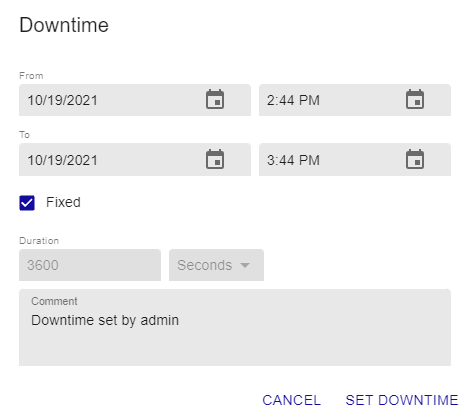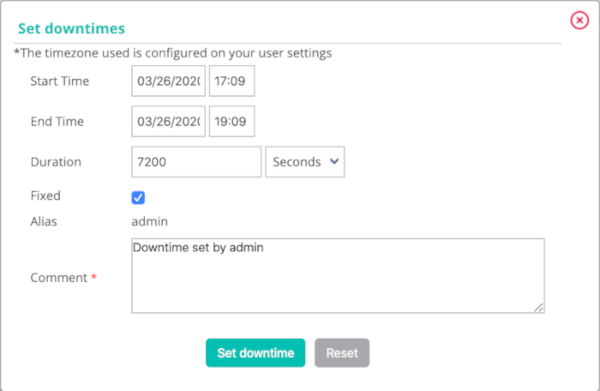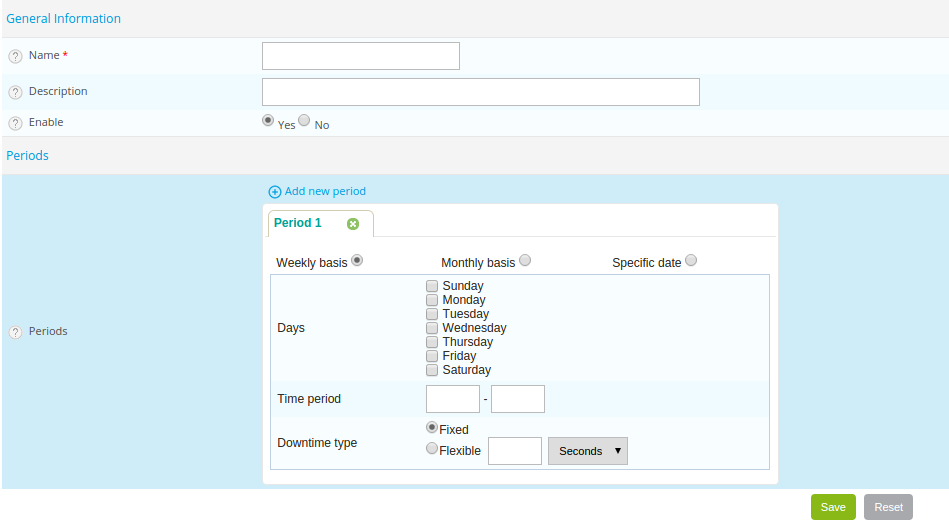Planning a downtime
Adding a downtime
Principle
A downtime period is a time period during which the notifications to a resource are disabled. Downtimes period are used during a programmed maintenance operation, they save us receiving false-positive alerts.
It is important to select all the resources necessary to prevent false-positives and false-negatives. In addition, the time spent in this state is taken into account during the generation of the availability data.
There are two types of downtimes:
- The fixed downtime: it starts and stops at the preview time.
- The flexible downtime: it starts during the preview time window as soon as an incident is detected and finishes when preview time in seconds expires.
Practice
There are several ways to define a downtime:
- From the Resources Status page
- From the detail sheets of a host or of the service
- From the real time monitoring interface
- From the Downtime menu
- Resources Status page
- Detailed sheet of an object
- Real time monitoring
- Downtime menu
-
Go to Monitoring > Resources Status.
-
Use one of the following methods:
-
Select the object(s) that you want to define a downtime on, then click the Set Downtime button above the list of resources.
-
Hover over the resource you want to define a downtime on, then click the Set Downtime icon that appears on the left.

The following window appears:

-
The From and To fields define the beginning and end date of the downtime. Downtimes cannot start or end after December 31, 2099, 11:59 pm.
-
If the Fixed box is checked the downtime is fixed. Otherwise, it is flexible.
-
If the downtime is flexible, the Duration field defines the length of the downtime.
-
The Comments field can be used to indicate why the downtime is defined.
-
-
Access the detail page of an object
-
In the category: Commands, click on Schedule downtime for this host/service
The following window appears:

- The Host Name field defines the host concerned by the downtime
- The Service field defines the service concerned by the downtime
- If the Fixed box is checked the downtime is fixed. Otherwise, it is flexible
- If the downtime is flexible, the Duration field defines the length of the downtime
- The Start Time and End Time fields define the beginning and end date of the downtime. Downtimes cannot start or end after December 31, 2099, 11:59 pm.
- The Comments field can be used to indicate why the downtime is defined
-
Go into the Monitoring > Status Details > Hosts (or Services) menu
-
Select the(s) object(s) on which you want to program a downtime period
-
In the More actions… menu, click on Hosts : Set Downtime or Services : Set Downtime
The following window appears:

- The Host Name field defines the host concerned by the downtime
- The Service field defines the service concerned by the downtime
- If the Fixed box is checked the downtime is fixed. Otherwise, it is flexible
- If the downtime is flexible, the Duration field defines the length of the downtime
- The Start Time and End Time fields define the beginning and end date of the downtime. Downtimes cannot start or end after December 31, 2099, 11:59 pm.
- The Comments field can be used to indicate why the downtime is defined
-
Go into the Monitoring > Downtimes > Downtimes menu
-
Click on Add a service downtime or Add a host downtime
The following window appears:

- The Host Name field defines the host concerned by the downtime
- The Service field defines the service concerned by the downtime
- If the Fixed box is checked the downtime is fixed. Otherwise, it is flexible
- If the downtime is flexible, the Duration field defines the length of the downtime
- The Start Time and End Time fields define the beginning and end date of the downtime. Downtimes cannot start or end after December 31, 2099, 11:59 pm.
- The Comments field can be used to indicate why the downtime is defined
Recurrent downtimes
Principle
A downtime period is a time period during which the notifications to a host or a service are disabled. Downtime periods are convenient during maintenance operations on a host or a service: they allow us to avoid receiving false positive.
Recurrent Downtime periods are Downtime periods that recurs repetitively.
E.g.: A back-up of the virtual machines is performed every day from 20h00 to midnight. This type of back-up has a tendency to saturate the CPU use of all the virtual machines. It is necessary to program recurrent Downtime periods on the services concerned to avoid receiving notifications from 20h00 to midnight.
The Downtime periods are taken into account in the calculation of the availability ratio of the resource in the availability report.
Practice
There are two types of Downtime periods:
- The fixed downtime period: This means that the downtime period takes place during exactly the time period defined.
- The flexible downtime period: This means that if during the time period defined the service or the host returns a Not-OK status the downtime period lasts a certain number of seconds (to be defined in the form) from the moment when the host or the status returns a Not-OK status.
To add a recurrent downtime period go into the Monitoring > Downtimes > Recurrent Downtimes menu and click on Add.

Configuration of Downtime periods
- The Name and Description fields serve to give a name and describe the recurrent downtime period.
- The Enable field serves to enable or disable the downtime period.
- The Periods field serves to define one or more periods of
recurrent downtime periods. To add a period, click on the symbol
.
It is possible to choose three types of period:
-
Weekly: to choose the days of the week
-
Monthly: to choose the days of the month
-
Specific date: to choose specific dates
-
The Days field defines the day(s) concerned.
-
The Time period field contains the time period concerned (expressed in HH:MM - HH:MM).
-
The Downtime type field defines the type of downtime period desired.
It is possible to combine several types of periods within the same downtime period.
Relations
- The Linked with Hosts list can be used to choose the host(s) concerned by the recurrent downtime period.
- If Linked with Host Groups is chosen with the list Linked with the host group all the hosts belonging to this group are concerned by the recurrent downtime period.
- The Linked with Services list can be used to choose the service(s) concerned by the recurrent downtime period.
- If a service group is chosen with the list Linked with Service Groups all the services belonging to this group are concerned by the recurrent downtime period.